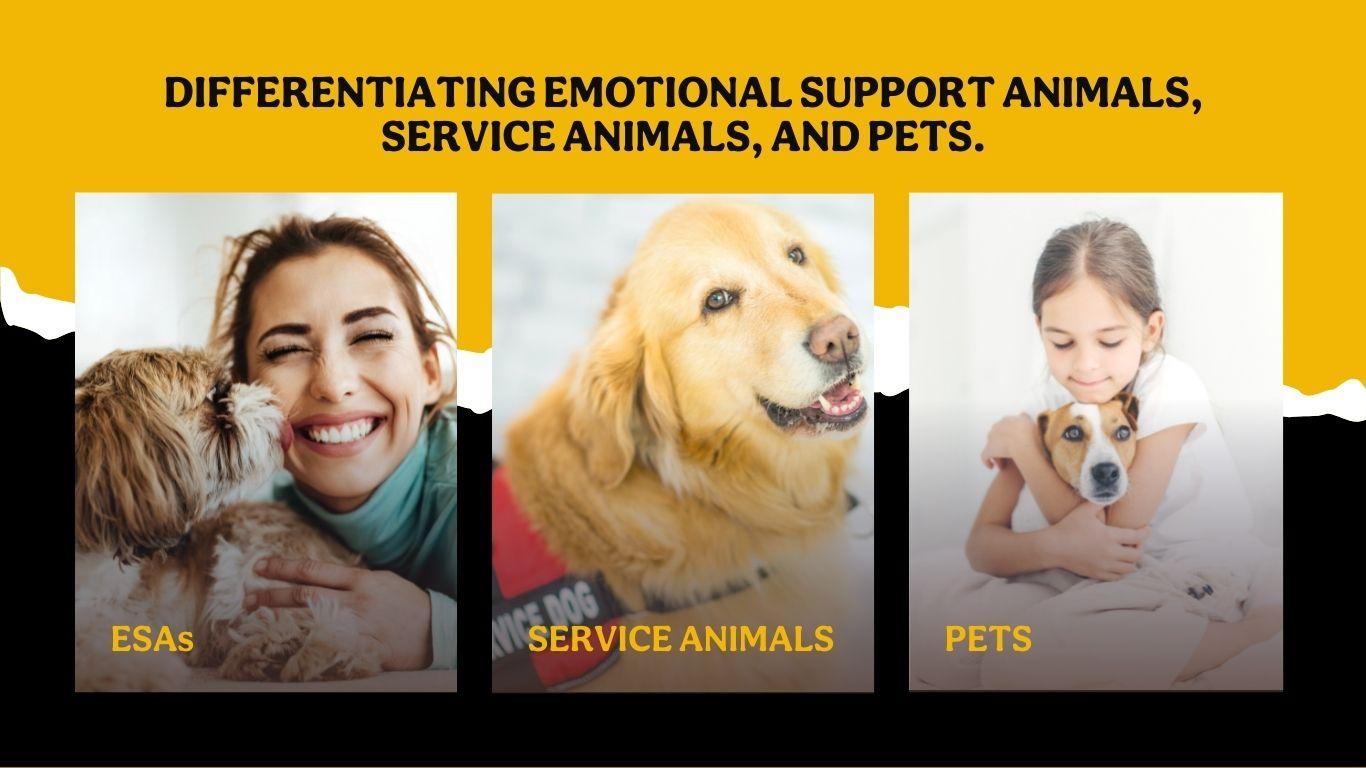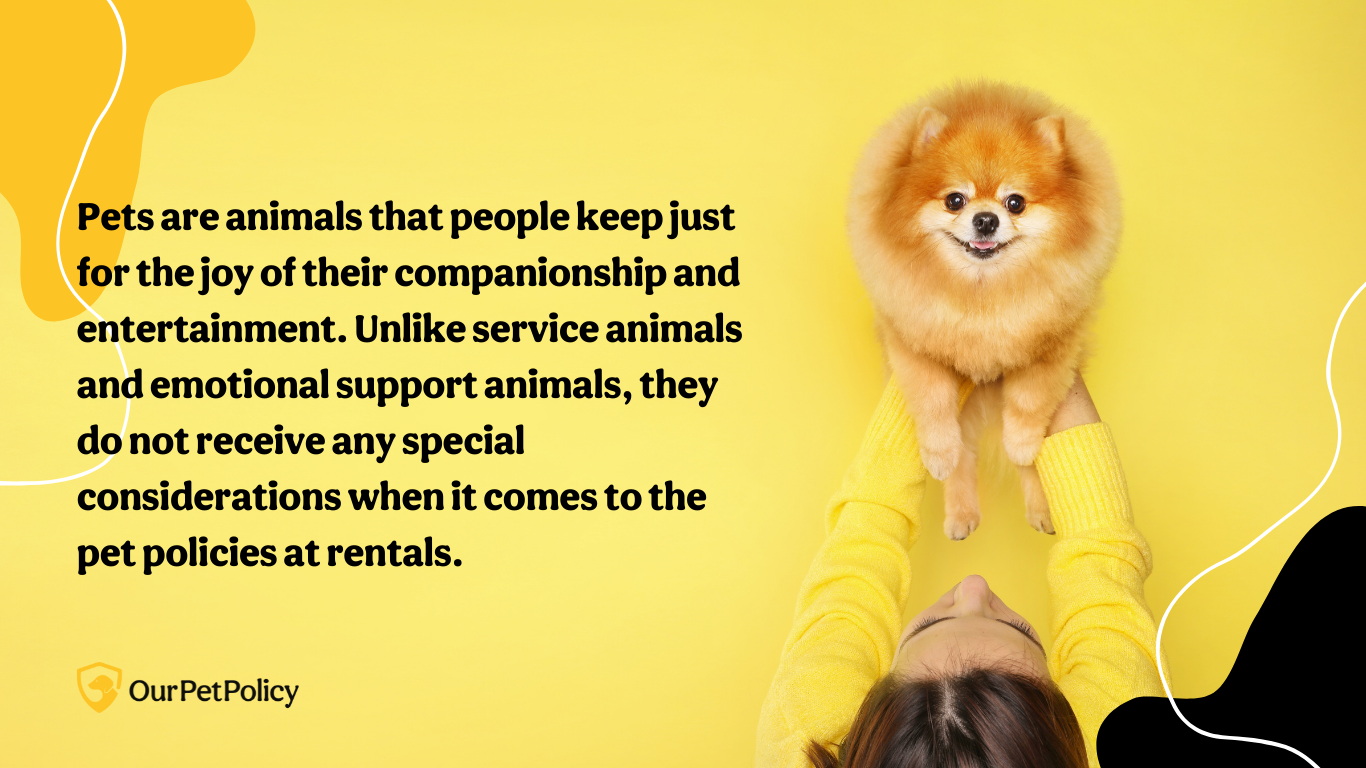Anyone that has a pet knows how significant their role in our lives can be. It’s no wonder that the two most common pets, dogs and cats, numbered over 130 million in 2020 in the US. Over the years, these furry friends have transformed into more than just household pets, they have become an integral part of many people’s physical and mental health. Understanding the differences between an emotional support animal, a service animal, and a pet is essential to understanding how to properly accommodate, manage, and appreciate these animals and those who rely on them.

Emotional Support Animals (ESAs)
With a steady rise in mental health awareness and a focus on providing the proper resources to those in need, emotional support animals (ESAs) have become an alternative solution in people’s lives replacing, or supporting, prescription medications and other forms of help. Also referred to as comfort animals or therapy animals, ESAs do not require any specific training and they can be any type of animal, according to the U.S. Department of Housing and Urban Development. It has been noted that people living with mental disabilities and mental illnesses find much-needed comfort and companionship from ESAs. ESAs have been said to alleviate certain symptoms, lessen loneliness, help with depression, anxiety, and even some phobias.

Emotional support animals receive different accommodations than a pet in some housing instances, as they are not considered pets. When it comes to renting, under the Fair Housing Act, individuals with an Emotional Support Animal may request reasonable accommodations and waive a “no pet policy”. This means that if the housing has a No Pet Policy on their premise, the ESA is permitted to reside on the property regardless of the policy so long as the animal does not pose a direct threat to the health or safety of others. Since emotional support animals are not considered pets, they are considered assistive aids. People with ESAs are protected from being asked about the existence, nature, and extent of their disability so long as a letter indicating the need for an ESA is presented. An ESA letter, provided by a doctor or mental health professional, not only waives a no pet policy but also exempts the individual from paying any pet fees.
Service Animals
Service animals are those animals that have undergone specialized training to perform certain tasks or work in aid of people with disabilities, which might include physical, sensory, psychiatric, intellectual, or others as defined under Title II and Title III of the ADA.

Service animals are allowed in public facilities and private businesses where emotional support animals are not. A business or building with a “no pet policy” does not apply to service animals, and they are always allowed entry where the public, program participants, clients, customers, or invitees are allowed. Furthermore, any establishment is not allowed to question the individual about the nature of their disability.
A business is only entitled to ask:
- Is the animal required because of a disability?
- What work or task has this animal been trained to perform?
Similar to an ESA, service animals are permitted to reside on a rental property regardless of a no-pet rule so long as the animal does not pose a direct threat to the health or safety of others.
Pets
Pets, on the other hand, are considered animals that people keep just for the joy of their companionship and entertainment. However, unlike the above-mentioned service animals and emotional support animals, they do not receive any special considerations when it comes to the pet policies at rentals. If a landlord has a “No Pet Policy,” then a resident is not allowed to have a pet regardless of whether ESAs or Service Animals are accommodated. If pets are allowed at a rental, then pet-owning tenants must agree to the rental’s specific pet policies, which can include pet fees, pet deposits, and/or pet rent.

Service animals, emotional support animals, and pets are all extremely important as they provide support, comfort, and as noted, some can aid in critical tasks and functions during times of need. Unfortunately, the help that ESAs provide is being taken advantage of by many people looking to find loopholes in the system simply to avoid paying pet fees, deposits, and rent or to evade no-pets-allowed policies so they can reside at any rental property. This has become a huge problem for landlords, and for those that truly need the help of these animals. In a 2019 report, the development of “ESA mills,” or for-profit organizations, that issue fake letters has caused the number of falsely registered animals to exponentially increase. People with genuine needs are now facing unjust scrutiny by those that have been adversely affected by fraudulent and false letters. Landlords aren’t able to collect the fees needed to effectively protect their properties from pet damage, repair costs, and pet liability. Unchecked, establishments and service providers have begun to resent legitimate assistance animals. This is an ever-growing issue that is being faced by so many in the community today.
A University of the Pacific article suggests that it may be necessary to put laws in place to address these loopholes in the FHA. However, it might take years for federal laws to be enacted while in the meantime, thousands are abusing the system. As a result, accommodating phony letters when there are legitimate people with disabilities and valid ESA letters out there deprive people who really need them while stigmatizing mental health. And as mentioned, property managers and landlords are unable to collect needed fees, while incurring pet damage and repair costs from poorly trained animals residing for free. Unfortunately, the true cost of these damages might be greater than most property managers and owners realize.
From just the simple furry household member to sources of emotional support, to providing life-changing services, pets have been a huge part of our lives for so long and will continue to do so. Establishing the correct pet policy, having the right process to vet fraudulent letters, and setting expectations is the best way to build a long-lasting and positive tenant-landlord relationship.
OurPetPolicy is an easy-to-use pet policy process that is vetted by lawyers to help protect your property.
We help empower property owners by eliminating potential loopholes, providing simple screening processes, and setting transparent rules and expectations between property owners and their tenants. Prevent further exposure to the scenarios listed above by enforcing a detailed policy that protects your property portfolio.
OurPetPolicy is a product of Landlord Tech, a software company designed to solve and prevent the problems that property managers and owners face through technology and automation.
